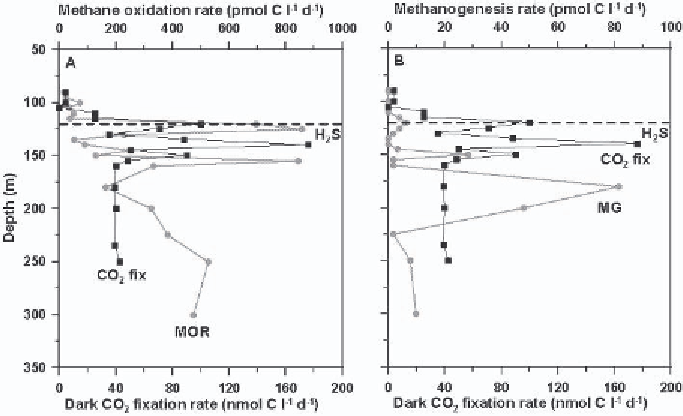Environmental Engineering Reference
In-Depth Information
For methane-oxidizing bacteria methane is both, the energy and cellular car-
bon source. Methane oxidation rates increased below the oxic/anoxic interface
and, on average, up to 40% of the oxidized CH
4
carbon was incorporated into
the organic matter [8, 39, 41, 53, Ivanov and Lein, this volume]. The highest
rates using
14
CH
4
were measured in the upper 100 m of the anoxic zone. The
zone of increased methane oxidation rates often but not always corresponded
to the increased rate of carbon dioxide fixation (Fig.5A). Maximum CH
4
oxi-
dation rate at this station was about 0.9 nM d
−
1
, but was as high as 8 nM d
−
1
in
the central western part of the sea. Reeburgh et al. [41] have used both,
14
CH
4
and C
3
H
4
labeled methane, to obtain rates in the range between 1 and 10
3
nM
d
−
1
. The water column rates were higher below 300 m. Our data obtained in
the upper anoxic zone are comparable with Reeburgh et al.' data. The abun-
dance and taxonomic composition of methane oxidizing bacteria inhabited the
chemocline were analyzed using MPN and direct immunofluorescence meth-
ods. Density of methane oxidizing bacteria at the oxic/anoxic interface was up
to 10
4
cells ml
−
1
and they were represented by several genera such as
Methy-
lomonas, Methylobacter, Methylococcus, Methylosinus,
and
Methylocystis
[8].
Figure 5.
Combined depth profiles of methane oxidation rates,
14
CH
4
, (MOR; panel A), total
(
14
CO
2
-lithotrophic and
14
C-aceate acetoclastic) methanogenesis rates (MG; panel B), and dark
14
CO
2
fixation rates (CO
2
fix) in the open Black Sea at Station 4 in May 1988; 44˚20.23'N,
32˚09.54'E, depth 1998 m.
The presence of aerobic methane-oxidizing bacteria was detected down to
400-500 m using immunofluorescence method [8]. Rate measurements, how-
ever, suggest that methanotrophs may exist in the water column down to the

